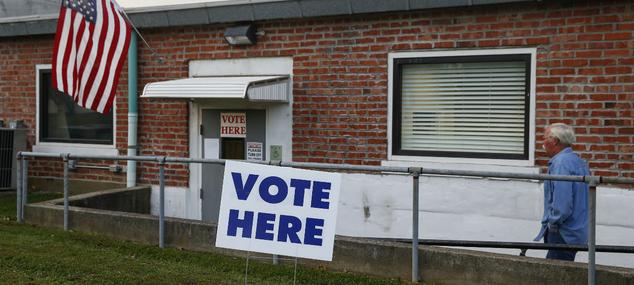Story Highlights
- Less than half in U.S. have given much thought to the election
- Ten-point drop since 2010 in those "certain" they'll vote
- Certainty to vote plunges this year among independents
PRINCETON, N.J. -- Two of Gallup's long-term indicators of voter turnout show that Americans are much less interested in the midterm election today than they were on the eve of the election in 2010. Moreover, the 41% of U.S. adults saying they have given "quite a lot" or "some" thought to this year's election is the lowest Gallup has recorded on the eve of any of the last six midterms. The 58% saying they are absolutely certain they will vote ties with 1998 for the lowest.
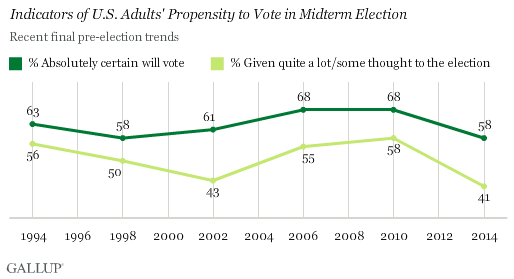
Additionally, after two midterm elections with above-average voter enthusiasm, the percentage of Americans saying they feel less enthusiastic than usual about voting this year (48%) now exceeds the percentage who say they are more enthusiastic (40%). This is similar to the pattern seen in each midterm from 1994 through 2002.
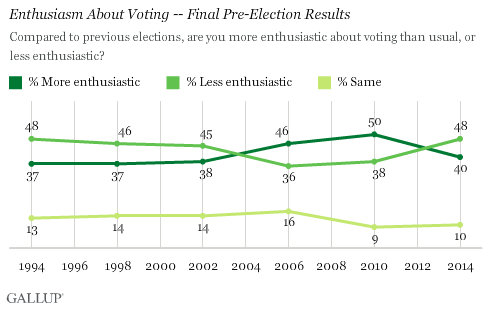
The clearest indication that turnout will be lower than four years ago is that more than a quarter of U.S. adults -- 27% -- say they do not plan to vote in this year's election, up from 20% in 2010. This does not mean that all others will in fact vote, but it is a useful metric to gauge relative turnout across elections.
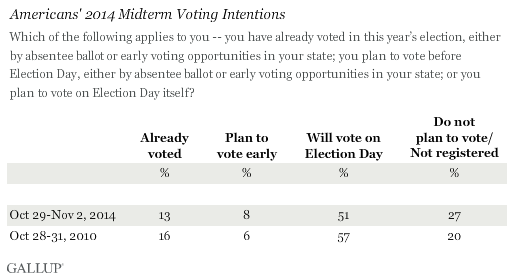
Independents' Voter Engagement Declines Sharply
One of the most striking findings in the poll is that intent to vote has plummeted among political independents. The 41% saying they are "absolutely certain" they will vote is down 19 percentage points from 2010, easily the lowest level of independents' intended turnout in any midterm since 1994. Meanwhile, intent to vote among core Republicans and Democrats has subsided to normal levels after matching or hitting new highs in 2010.
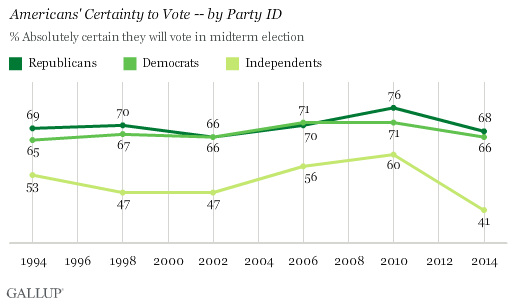
To elaborate on this point, intent to vote has declined substantially since 2010 among independents who lean toward each of the major political parties: It is down 25 points among independents who lean Republican and down 20 points among independents who lean Democratic. Meanwhile, intent to vote among pure independents -- those who do not lean toward either party, and who generally are the least likely to say they plan to vote -- has declined by just eight points. Thus, the hard-core partisans on both sides have generally maintained high interest in voting this year, albeit somewhat reduced, while those less attached to either party have significantly downgraded their interest.
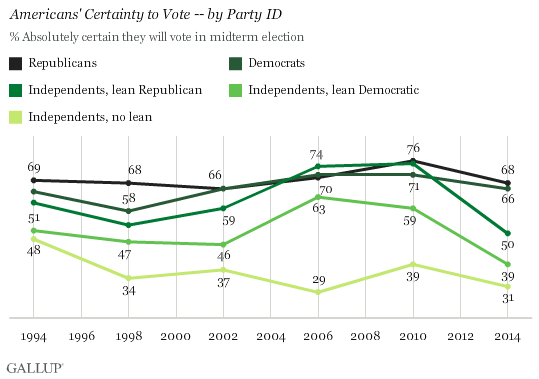
Bottom Line
The 2014 election has provided politicos with great political theater, including a number of close Senate races that will determine whether Republicans capture the majority in the upper chamber and numerous hard-charging Republican candidates aiming to expand the GOP majority in the House. But somehow this has failed to ignite the interest of independents, and even core partisans' attention has waned a bit. One explanation could be the near certainty that the outcome will not transform the balance of power in Washington. Even if the Republicans win the Senate and hold the House, there will still be a division of power in Washington with a Democratic president. Without the opportunity to effect more major change, Republican- and Democratic-leaning independents may see less of a reason to pay attention or vote.
Another explanation could be the lack of a galvanizing issue for either party -- such as the Iraq War provided the Democrats in 2006 and "Obamacare" provided the Republicans in 2010. A third reason could be the lack of a popular figurehead for either party driving their base to the polls. President Barack Obama is surely trying to do what he can, but with his approval rating hovering near 40% nationally, and now below 60% among conservative Democrats, his pull is limited. Plus, neither party's leader in Congress is highly popular nationally, or among his own party base. Finally, the hyper-partisan nature of politics over the past few years could be a turnoff to some voters, particularly independents.
As discouraging as low turnout may be for those who care deeply about citizen engagement, and who would like to see more Americans exercising their right to vote, the trends make it clear that voter participation has the capacity to spring back. The 2014 midterm represents a year when many of the variables that can affect turnout conspired to suppress it; however, a change in even one of these factors next time -- a popular party leader, a strong issue-based platform or a clear opportunity for either party to consolidate power in Washington -- could make all the difference.
Meanwhile, the drop in interest in the 2014 election among independents leaves the outcome more directly dependent than ever on partisans of both sides, and in that regard underscores the obvious efforts of late to increase turnout among voters whose political predilections are already known, rather than attempting to change voters' minds about whom to vote for.
Survey Methods
Results for this Gallup poll are based on telephone interviews conducted Oct. 29-Nov. 2, 2014, with a random sample of 1,832 adults, aged 18 and older, living in all 50 U.S. states and the District of Columbia.
For results based on the total sample of national adults, the margin of sampling error is ±3 percentage points at the 95% confidence level.
Interviews are conducted with respondents on landline telephones and cellular phones, with interviews conducted in Spanish for respondents who are primarily Spanish-speaking. Each sample of national adults includes a minimum quota of 50% cellphone respondents and 50% landline respondents, with additional minimum quotas by region. Landline and cellphone telephone numbers are selected using random-digit-dial methods. Landline respondents are chosen at random within each household on the basis of which member had the most recent birthday.
Samples are weighted to correct for unequal selection probability, nonresponse, and double coverage of landline and cell users in the two sampling frames. They are also weighted to match the national demographics of gender, age, race, Hispanic ethnicity, education, region, population density and phone status (cellphone-only/landline only/both and cellphone mostly). Demographic weighting targets are based on the March 2013 Current Population Survey figures for the aged 18 and older U.S. population. Phone status targets are based on the July-December 2013 National Health Interview Survey. Population density targets are based on the 2010 census. All reported margins of sampling error include the computed design effects for weighting.
In addition to sampling error, question wording and practical difficulties in conducting surveys can introduce error or bias into the findings of public opinion polls.
